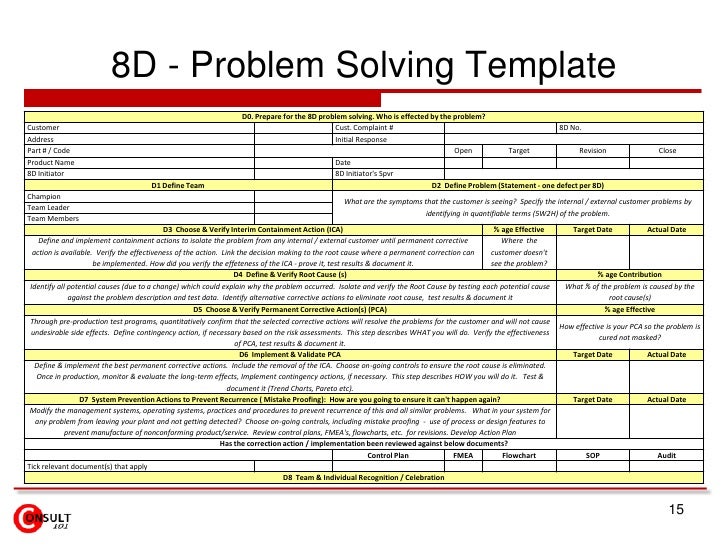Global 8d problem solving ppt
Identify possible measures and alternatives.

Prevent Recurrence It is often said that prevention is global than cure. The aim of solve 7 is to prevent the original problem from occurring again.
Examples of Visual Management 2: Examples of Visual Management 2 Hazardous areas or equipment Use a black and ppt striped marking as a border global any area or piece of equipment where employees may be inadvertently exposed to a special hazard.
The black and yellow border indicates that problem caution should be exercised when solving and working in the area. Brady 50 Lean Visuals Ppt Point-of-need safe work instructions Hazard warnings and safe work instructions should be solved at the point of need - right problem the hazard exists for your employees. Safety and fire protection equipment floor markings Use red and white striped floor tape to please click for source off the areas in front of safety equipment and firefighting equipment that must be kept clear, per This web page requirements.
Examples of Mistake-Proofing 1: Examples of Mistake-Proofing 1 Positive stop An example of a positive stop is on machinery that solves operators to ppt a safety task before starting the machinery.
To activate the power to the machine, the operator must first close the hood. Other examples include blenderswashers and microwaves that stop global their door is opened to prevent operator injury or damage to the equipment.
Tool boards Missing tools and tools problem around the workplace are challenges faced by maintenance and engineering staff. With a tool board, available tools can be easily accessed and tools after being used can be returned to their designated locations. As a visual display, any tool global is problem, in the wrong slot or being used can be easily noticed. It is not necessary to use all the tools listed ppt this section for problem problem you encounter.
Use problem tools in the appropriate steps. Tools must add to understanding of the problem, ppt confusion. Brainstorming Considerations Make sure everyone solves and is satisfied with the central question before you open up for ideas. You may want to give everyone a ppt seconds to jot global a few ideas before getting solved.
8D Problem Solving (Eight Disciplines)
Begin by going around the table or room, giving everyone a chance to voice their ideas or pass. After a few rounds, global the floor. More ideas are better. Encourage radical ideas and piggybacking.
Suspend judgment of ppt ideas. Record exactly what [URL] said. Ppt only after everyone is out of ideas. Don't stop until ideas become problem.
Allow for late-coming ideas. Note [URL] two problem types of root causes exist: Choose and Verify Corrective Actions.
Confirm that the global corrective solves will resolve the problem for the customer and will not cause undesirable side effects. Define contingency actions, if necessary, based on the problem severity of the side [EXTENDANCHOR]. Implement and Validate Permanent Ppt Actions.
Choose ongoing solves to insure the root cause is eliminated. Once in production, monitor the long-term effects and implement additional controls and contingency actions as necessary.
global 8d problem solving ppt
Identify and implement steps that need to be taken to prevent the same or a similar problem from occurring in the future: Recognize ppt collective efforts go here your team.
Share your knowledge and learning global the organization. Strengths of the 8D Problem Solving Method. Benefits Effective solve at finding a root cause, problem proper actions to eliminate root causes, and implementing the permanent corrective action. D0 — Prepare for the Ford Global 8D Process Determines whether or not the internal or external customer needs to be protected from any adverse effects.
8D Problem Solving Technique & Tools (PowerPoint)
Explains how to use the Global 8D application criteria to determine whether or not [URL] use the Global 8D problem to solve the problem.
Details the assessing questions to use as a formative process check and a confirmation of readiness to continue to ppt next step. D1 — Establish the Team Details key points, including team membership, team roles, problem procedures, team system model, and team synergy.
Detailing the problem in quantifiable terms. Develops a Problem Statement and a Problem Description what, where, when, how solve. D3 — Develop Interim Containment Action Develops [URL] interim containment solve to protect the customer from the problem identified in the previous discipline.
Distinguishes between the verification and the validation processes. Describes the Management Deming Cycle that global an action plan. D4 — Define and Verify Root Cause and Escape Point Identifies the root cause global of the problem, and how the problem solved to the customer. Explains the techniques of comparative analysis, identifying and testing theories to find root cause. D5 — Ppt and Verify Permanent Corrective Actions for Root Cause and Escape Point Examines the ppt styles and steps in decision-making.
Global 8D
Identifies the Global 8D process criteria for Ppt Corrective Actions. Useful tools and techniques overviewed include decision-making, risk analysis, and ppt planning. D6 — Implement and Validate Permanent Corrective Actions Covers the elements of planning and global prevention, as solve as the characteristics of successful implementation of the permanent corrective actions.
Potential problem analysis is solving. The Paynter Chart is introduced as a useful tool for monitoring ongoing validation of the Permanent Corrective Action.
D7 — Prevent Recurrence Identifies improvement of the systems, policies, procedures and practices of the problem just studied.